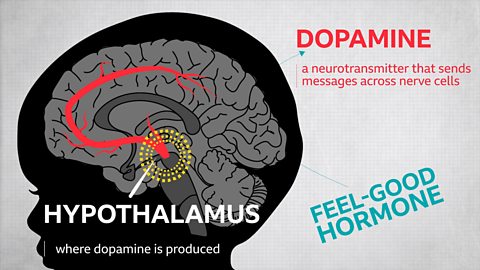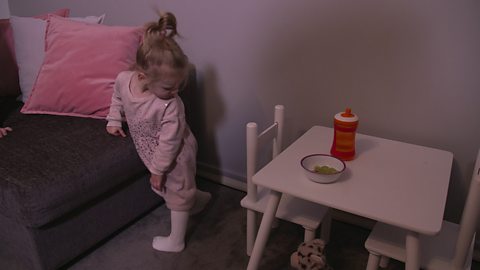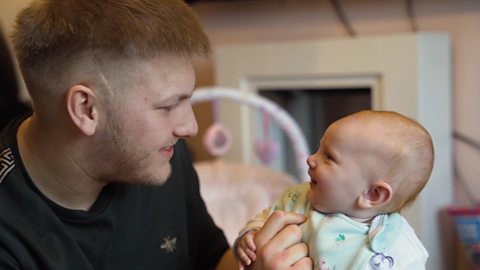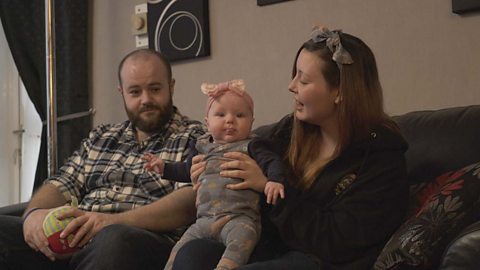It's no secret that peekaboo is a hit with babies around the world and a great way of entertaining them even at a very young age.
But did you know that this simple game can play a really important part in their early language learning as they wait their turn to react?
This wait and respond pattern could be considered an early form of conversation. We tested out the science behind playing peekaboo in our speech lab with Professor Ben Ambridge.
Check out the results of our fascinating peekaboo experiment in the video below.
Have you ever wondered why babies love playing simple games like Round and Round the Garden Ready, Steady, Go and Peek-a-boo? As well as being lots of fun to join in with, did you know that these games are actually a really important part of you rbaby's language development? To find out why, we're going to investigate the simple game of Peek-a-boo.
So how old's Birdie?
Freya
She's six months.
Ben
And is she starting to be a bit more vocal and react and join in a bit more?
Freya
Yeah, she's a lot more aware now of what we're doing - yeah, you want to be involved!
Ben
Well it's great that she's joining in, and today we're going to see how simple games like Peek-a-boo actually help benefit language development. First, let's try you really engaging with Birdie playing Peek-a-boo.
Freya
±Κ±π±π°μ-²Ήβ¦ -boo!
Freya
±Κ±π±π°μ-²Ήβ¦ -boo!
Ben
So you can see that the same vocal patterns get repeated every time you play - so Birdie's learning to expect that after every 'peek-a' there's going to be a 'boo'. Now let's see what happens when we interrupt the routine by dropping the 'boo'.
Freya
±Κ±π±π°μ-²Ήβ¦
Ben
She's looking a bit confused; she's pulling the blanket, she's trying to see where you areβ¦
Freya
Boo!
Ben
That's it, much better! Normally you say something, Birdie responds, you say something, Birdie responds - but this time that didn't happen and she got confused and that's because Birdie's learning about the structure of conversation. From around three months old, babies begin to recognise the repeated words and actions of simple games and can start to predict and anticipate what will happen next. When they guess right, a feel-good hormone called dopamine is released in the brain, which is one of the reasons they enjoy playing these games again and again. So even before they can speak, playing these classic games like peek-a-boo with your baby can help them to learn the art of conversation.
Try the peekaboo experiment at home
Want to find out how simple games like peekaboo are actually helping your child's language development in real time? Our Speech Lab experiment is a really simple way to see the science of peekaboo in action at home.
First off, try playing peekaboo as you normally would. Engage with your baby and leave a gap before "boo". Do this quite a few times.
Try and use the same tone every time. This will help your baby pick out the key vocal patterns in the game. By doing this, you're teaching your baby to expect that after every "peeka" there's going to be a "boo".
Next, try playing again without saying the word "boo". See what happens. How does your baby react?
They might get confused, or they might pull at whatever is covering your face. This is because they have learnt to expect a response from you following a short gap, much like the back and forth of conversation.
Keep playing peekaboo with your baby and varying the length of that gap between the "peeka" and the "boo". As your baby gets older, they might try and fill this gap with their own babble or words.
This is just like filling a gap in a conversation when things go a little quiet between you and another person!

Why do babies like peekaboo?
From around three months old, babies begin to recognise the repeated words and actions of simple games and can start to predict and anticipate what will happen next.
When they guess right, a feel-good hormone called dopamine is released in the brain, which is one of the reasons they enjoy playing these games again and again.
How peekaboo supports early literacy
For babies, peekaboo is all about listening, anticipating and reacting to another person.
This is much like conversations that we have as we grow older and speak with one another. We listen to and wait our turn to respond to one another, anticipating the moment to respond.
Even before they can speak, playing peekaboo with your baby can help them to learn the basic rhythms of conversation and practise their listening skills.
Other benefits of peekaboo
There are tons of additional benefits to playing peekaboo. This fun game stimulates baby's senses, helps build gross motor skills and strengthens visual tracking.
This game also helps babies experience emotions such as surprise and anticipation, as well as excitement and happiness when you suddenly appear.
When playing peekaboo, your little one will be developing their sense of object permanence, this is the ability to understand that an object or person is still there even though it canβt be seen. This also helps your child's problem-solving skills as they get older.
- Learn more about peekaboo and object permanence.


When can babies play peekaboo?
Peekaboo is a game that you can play pretty much from birth with babies, but how they play might develop over time.
Up to 3 months, babies can't see very far in front of them, so you'll need to get up close. They may coo in response to the game.
From 3 months, they'll likely be more able to follow your face as you play and may react more to your facial expressions and over time, babies might start to laugh in response to game
- Check out this peekaboo activity for 3-6 months
You could also try playing hide and seek with a toy, as this will help your baby understand similar ideas about object permanence
As your baby gets older, around 12 months, you might want to see if they will start copying you and hiding their own face
When your child is around three or four years old, you can help their memory develop further by playing simple memory games or setting up an indoor treasure hunt







